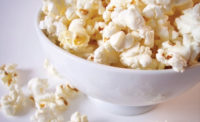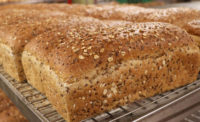Better-for-you remains a key macro trend in food today, and the hottest sales activity in salty snacks neatly illustrates its potential. Simultaneously, we see various flavor trends driving growth of traditional and better-for-you snacks, each with its own set of distinct formulation and marketing tactics.
Some of the strongest growth in salty snacks today is in extruded products, with sales seeing a boost from the lighter, clean- label and/or better-for-you products made possible through extrusion technology.
A key extruded snack segment is cheese snacks, up 6.91 percent in dollar sales for the 52 weeks ending Jan. 24, 2016, per IRI, Chicago, valued at just under $2.0 billion. While traditional Cheetos remain solid as a $1.5 billion brand, and growth of 6.83 percent dollar sales for the year, better-for-you launches have diversified revenue for Frito-Lay North America. The company’s Simply Cheetos, up 21.62 percent in dollar sales for the period, includes front-of-pack (FOP) notations like “Gluten Free”; “Made With Expeller-Pressed Sunflower Oil”; “No Artificial Flavors, Colors or Preservatives”; “Made With Sea Salt”; and “Baked.”
The $3.9 billion segment of “other salted snacks,” which includes products like vegetable chips and straws, also saw positive growth, up 6.70 in dollar sales. Sensible Portions Garden Veggie Straws, a Hain Celestial Group brand, saw notable growth of 61.07 percent in dollar sales for the year. Calbee Harvest Snaps, now a $71.7 million brand, grew by 62.34 percent in dollar sales. The line includes products like Original Green Pea Crisps, made with pea powder and featuring FOP language like “Gluten Free”; “Baked”; “50% Less Fat”; “Good Source of Fiber”; and “Low Sodium.”
But better-for-you snacks aren’t the only drivers of growth in extruded snacks today. The mashup of two Frito-Lay favorites, Cheetos Doritos—a mix of Cheetos Crunchy Flamin’ Hot Cheese Flavored Snacks and Doritos Dinamita Chile Limón Flavored Rolled Tortilla Chips in one bag—gained 73.96 in dollar sales for the year, taking in $128.6 million.
Potato chips accounted for $7.2 billion in sales for the 52 weeks ending Jan. 24, per IRI, but the segment overall was only up 0.90 percent in dollar sales. Cape Cod Potato Chips, a subsidiary of Snyder’s-Lance, saw growth of 13.09 percent in dollar sales for the year. Kettle Brand, a Diamond Foods brand, also saw a healthy level of growth, up 8.92 percent in dollar sales.
While the $1.2 billion pretzel segment remained flat—down 0.13 percent in dollar sales for the period—one bright spot was Unique Pretzel Bakery’s Unique Splits, up 39.54 percent in dollar sales for the year, per IRI. (For more on Unique Pretzel Bakery, the 2016 Snack Food & Wholesale Bakery Snack Producer of the Year, see “Unique pretzel strength” in the February 2016 issue.)
Salty-sweet continues to attract interest. Snyder’s of Hanover Sweet and Salty pretzels, a Snyder-Lance’s brand, was up a very strong 357.44 percent in dollar sales. The line, launched in January 2014, includes flavor profiles like Cinnamon Sugar and Salted Caramel. Snyder’s-Lance also includes a salty-sweet profile in its new Poppers line of hollow pretzels, offering a Cinnamon Sugar product in addition to Original and Three Cheese.
Extruded to perfection
The flexibility of extrusion technology helps producers better align products with better-for-you snacking. “Trends in the snack market are mirroring many of the trends in the food industry as a whole, specifically an increase in consumer interest in protein, eating on the go and ‘free-from,’” says Keith Graham, marketing manager, Baker Perkins Ltd., Peterborough, England.
“The health-and-wellness trend continues, and we see significant interest in processing gluten-free raw materials and specialty ingredients such as ancient grains and pulses,” says Mike Shaw, sales manager, snacks, Buhler, Plymouth, MN. “The Food and Agriculture Organization of the United Nations has declared 2016 as the ‘International Year of Pulses,’ and there is worldwide promotion of various types of pulses, including beans, lentils and peas.
“There is significant value to snack companies in utilizing these raw materials in their extruded snack products,” continues Shaw. “This makes pulses an idea choice of raw material, since pulses have high amounts of protein, fiber and other nutrients, and are good functionally to be used for extruded products.”
Extruders can process a wide range of ingredients, including flours from grain, ground legumes, vegetables, proteins and so on, notes Graham. “Simple changes to screw and die configurations enable the final texture and shape of the product to be altered, and there is a range of post-extrusion forming options that can be used after the extruder,” he says. “The result is a very wide range of product-development options, from commodity direct-expanded products up to highly sophisticated products aimed at an ever-widening variety of upmarket niches.” One of the main benefits of an extruder is the ability to switch between these different products quickly and easily, he adds.
“Extruded snacks are cooked in the extruder, so frying is not necessary,” says Graham. “Some oil is usually applied for flavor, but fat content of extruded snacks can be kept very low. The vast range of ingredients that can be processed in an extruder means that formulations aimed at any of the ‘free-from’ niches, the biggest of which is wheat- and gluten-free, are easily achieved.”
Snack dynamics
Regardless of salty snack product positioning, the importance of flavor remains undiminished. “Taste and texture are still the main priority for snacks,” says Graham. “Savory and salty tastes still predominate, but there is increasing interest in spicy and ethnic flavors.”
Some better-for-you snacks can have a slightly stronger flavor from the ingredients used, notes Kim Cornelius, food technologist, Wixon, St. Francis, WI, so bold flavors, such as garlic herb, chile lime or smoky chipotle Cheddar, work well. “Flavor profiles that continue along with the health halo, such as vegetable profiles like garden roasted vegetable and grilled smoky tomato, or flavors that use spices with health benefits, such as citrus ginger or honey cinnamon, are great combinations with better-for-you snacks,” she says.
Marc McCullagh, senior brand manager, Kettle Brand, Salem, OR, notes the rising popularity of pickled and fermented foods like sauerkraut and kimchi. “As our innovation team watched these trends gain steam across many categories, they began exploring briny, tangy flavors back in 2014,” he says. This research yielded two of Kettle Brand’s current best-selling flavors—Pepperoncini and Krinkle Cut Dill Pickle—which launched in late 2014.
“For the salty snack market, there seems be to a slight shift from heat and sweet to heat and tangy or salty and tangy,” says Cornelius. “Consumers are looking for a flavor punch, something that is bold and stimulates the taste buds. Such combinations might be <em>ají amarillo</em> and lime, soy sauce and sour orange, and lemon zest and sour cherry.” Other global chiles making their way into salty snacks include Turkish chiles like <em>aleppo</em> and <em>Urfa biber.</em>
The chips segment also has seen expansion into a wider range of substrates. “We’re seeing different bases—including assorted root vegetables—and frying oils gain steam in the category,” says McCullagh. “This year, we launched our new Kettle Brand Uprooted Vegetable Chips in two varieties—sweet potatoes, and a medley of sweet potatoes, beets and parsnips.” He also notes that Kettle Brand just launched a new line of chips cooked in 100 percent avocado oil and seasoned with infused salts in three flavors: Himalayan Salt, Chili Lime with citrus-infused sea salt and Hawaiian Barbeque with ginger-infused sea salt.
“Specialty salts, such as Himalayan Pink Salt, flavored salts or naturally smoked salts, for example, are viewed by consumers as a premium item on their own, so using them in a product elevates that product’s status,” says Naomi Novotny, president, SaltWorks Inc., Woodinville, WA.
“Consumers want shorter and understandable ingredient lists,” says Novotny. “We produce a variety of all-natural and unrefined salts for those looking to provide clean labels and thoughtful ingredients to consumers without skimping on taste and satisfaction.” She points to flavored and smoked sea salts, such Yakima Applewood Smoked Sea Salt or the spicy Fusion Chipotle Salt to add a unique twist to a salty snack.
Such designations connect shoppers to ingredients in a more-meaningful way. “Our goal is to create a snack that tastes just like the food that inspired it,” says McCullagh. “So when you bite into a Pepperoncini chip, you’ll recognize that tart, briny and slightly spicy flavor that most people experience when they eat real pepperoncinis.”
Forward thinking
Cornelius notes the potential for using “unexpected” flavor profiles in salty snacks, such as fried chicken potato chips or garlic shrimp pretzels. “These are flavors that you wouldn’t normally think of on a salty snack,” she says, “but they work.” She also notes flavors are going global, such kimchi-flavored potato chips.
Graham believes that snack producers can take better-for-you formulations to a higher level. “Conventional salty snacks are seen as occasional indulgent treats,” he says. The challenge for the snack industry, he notes, is to use high-protein, natural ingredients to make truly healthful snacks.
While it might not prove worthy of FOP messaging (yet), satiety could also potentially factor into formulation rubrics. “Satiety is another key requirement, and protein is known to be the most-satiating macronutrient,” says Graham. “While it would be a stretch to claim that most consumers understand this, the ability of a snack to make consumers feel fuller for longer is a characteristic that they will appreciate.”
Organic and non-GMO product positioning could also build shopper appeal. “Trends like organic are what we need to look for,” says Justin Spannuth, vice president and COO, Unique Pretzel Bakery, Reading, PA. “Non-GMO is another trend that has more legs than some people believe it warrants, but it’s still a trend that cannot be ignored. The next big trend that is just catching fire is sprouted grains. Properly sprouted grains allow for better digestion and more nutrients.”
McCullagh notes that in 2012, Kettle Brand became the first potato chip to be verified by the Non-GMO Project. Today, the brand offers more than 35 Non-GMO Project Verified flavors. “The hottest better-for-you trend we’re seeing right now is the continuing interest in clean ingredients,” he says.
Balancing these myriad attributes, such as organic, non-GMO, better-for-you and free-from, along with all-important quality, flavor and texture, in a salty snack can pose significant challenges.
“This is where knowing is half the battle,” says Spannuth. “Snack manufacturers have to rely on science and data more than ever before—understanding the actual benefits of a new ingredient and knowing if that benefit is, or will be, important to the consumer. Also, creating a product today for a fad that will not be important tomorrow is something else that needs to be evaluated in the process of creating a new product. In the end, it’s all about the return on investment.”












